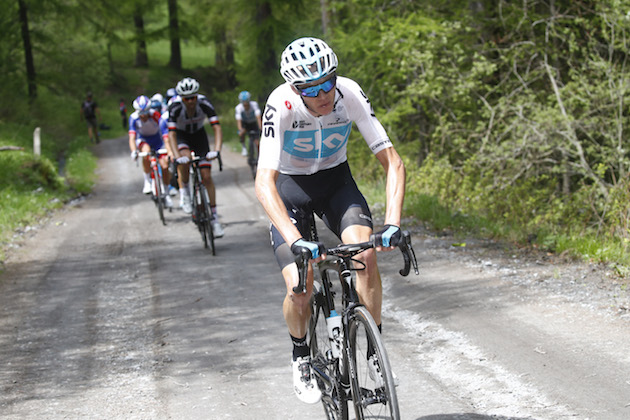What numbers do you need to win the Giro d'Italia? Chris Froome's power data analysed
We take a look at Chris Froome's power data from the Giro d'Italia, as revealed by Velon.

Chris Froome on the attack during stage 19 of the Giro d’Italia
Chris Froome's victory in the 2018 Giro d'Italia may have been delivered with a long range attack on stage 19 that seemed like something from another era, but that even that move was pre-planned and scientific - as revealed by Dave Brailsford after the stage.
Every second of Froome's Giro d'Italia power was recorded by Velon, which has now released a few details of his power from key stages including that memorable attack on the Colle delle Finestre.
However earlier in the race Froome had taken an impressive stage win on Monte Zoncolan, attacking four kilometres from the top of this super-steep climb. In the initial 1.3km of his attack, Froome averaged a massive 465 watts for more than six minutes before Simon Yates counter-attacked behind to nearly catch his Team Sky rival by the line.
>>> How much prize money did Chris Froome get for winning the Giro d'Italia?
Unfortunately for Froome he then lost time on the following stage to Sappada, before regaining some time on stage 16's time trial and finally springing into life with his brilliant attack on stage 19.
Froome's attack on the Colle delle Finestre with 80km to go saw him average 397 watts for 11-03 as he opened up a 40 second gap on Tom Dumoulin, Thibaut Pinot, Miguel Angel Lopez and Richard Carapaz. Interestingly Dumoulin's power for the same section was remarkably similar to Froome's, with the Dutchman averaging 395 watts.
Having crested the climb with a relatively slender advantage, Froome then opened more of a gap on the descent off the Finestre averaging 53.4kmh and hitting a maximum speed of 80kmh as Dumoulin decided to wait for Sebastien Reichenbach to catch up behind.
The latest race content, interviews, features, reviews and expert buying guides, direct to your inbox!
From there Froome covered the 16.2km climb to Sestriere at 23.2kmh before holding off Dumoulin once again on the final climb of the Jafferau to win the stage and move into the pink jersey.
>>> France vs Froome: Why Chris Froome can expect a more hostile reception at the Tour de France
The penultimate stage saw Froome being able to ride more defensively as he sought to defend a 40-second lead over Dumoulin, and despite not coming under pressure until the final climb still had to put in a few sizeable efforts, including averaging 380 watts for the first eight minutes of the Col Saint Pantaléon which saw him hit a maximum speed of 41kmh on the six per cent climb.
However the race all came down to the final climb to Cervinia where Dumoulin launched numerous attacks to try and put Froome under pressure which Froome was able to match and even launch a few counter-attacks of his own.
In order to cover this move Froome averaged 420 watts for nearly 10 minutes, including two 30-second efforts at 540 watts as he launched a couple of attacks of his own - seriously impressive numbers in any context, let alone at the end of a 214km stage on the penultimate day of a three week Grand Tour.
Henry Robertshaw began his time at Cycling Weekly working with the tech team, writing reviews, buying guides and appearing in videos advising on how to dress for the seasons. He later moved over to the news team, where his work focused on the professional peloton as well as legislation and provision for cycling. He's since moved his career in a new direction, with a role at the Department for Environment, Food and Rural Affairs.